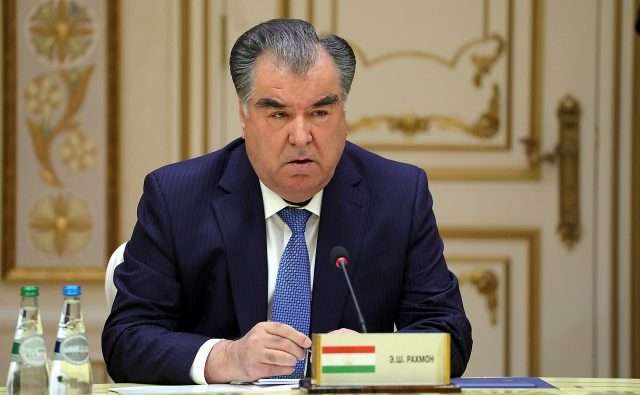
Tajikistan and China discussed economic, political and regional security cooperation, confirming Beijing’s rising role in Tajik local dynamics and Central Asia at the expense of Moscow’s regional strategy.
On August 1st, 2022, Tajik President Emomali Rahmon received Chinese Foreign Minister Wang Yi. The officials discussed current issues of cooperation, in particular, the trade and economic component, healthcare, investment and transport, and security in the region.
According to Emomali Rahmon, Dushanbe and Beijing are close neighbours that would like to deepen their cooperation in different sectors. Indeed, China is the largest Tajikistan trade and investment partner and supported the Tajik Government in the fight against the pandemic.
Regarding the economic cooperation between the two parties, Tajik official sources reported that in the first half of 2022, the exchange of goods between the two countries increased by almost 80%, compared to the same period in 2021, amounting to more than 20% of Tajikistan’s total foreign trade turnover.
During the meeting, the parties evaluated cooperation issues in green technologies, industry, and the supply of Tajik agricultural products to the Chinese markets.
Geopolitical scenario
China plays a significant role in the Tajik economy by supporting local infrastructural projects linked with Beijing’s Belt and Road Initiative. Consequently, Tajikistan significantly relies on Chinese investments, which have become Beijing’s leverage on the Central Asian republic to increase its presence and influence and promote its foreign policy at the local level ( Central Asian republics’ economic dependence on China). Indeed, in 2011, Dushanbe’s substantial economic reliance on Beijing’s financial investments and the Tajik impossibility to pay back the Chinese loans allowed the People’s Republic of China to obtain 1,158 square kilometres of disputed territory in exchange for writing off the debt.
Since the U.S. troops’ withdrawal from Afghanistan and the Taliban’s rise to power in Kabul, Tajikistan has sought cooperation with regional actors such as the People’s Republic of China and the Russian Federation in security and military fields to contrast terrorist threats from the Afghan territory and guarantee local stability.
In this context, China supported the construction of a military base in the Gorno-Badakhshan Autonomous Region (GBAO) which borders the Xinjiang Uygur Autonomous Region (XUAR) (Chinese military base in Tajikistan: regional implications). In May 2022, this area registered significant protests and security problems which Dushanbe linked with “external threats and foreign terrorist groups” (Political tensions and security threats in Tajikistan).
Risk assessment
Tajikistan needs to maintain stability and security in the country, guarantee socio-economic development, and contrast local disappointment and jihadist propaganda promoted by terrorist groups such as the Islamic State Khurasan Province (ISKP) (Islamic State Khurasan Province threatens Uzbekistan, Central Asia, and neighbouring countries) or the newborn Tehrik-e Taliban Tajikistan which operates in the north of Afghanistan and seeks to overthrow Dushanbe Government (Tehrik-e Taliban Tajikistan and terrorist threat in Tajikistan and Central Asia).
According to Tajik official sources, terrorism and extremism have increased in Tajikistan in 2022. They might exploit local tensions and socio-economic problems to promote their propaganda, recruit foreign fighters among the young generations and destabilise the country (The number of terrorists and extremists has increased in Tajikistan).
In this context, the People’s Republic of China constantly analyses the security situation in Tajikistan since this Central Asian republic is part of the Belt and Road Initiative and shares its borders with the Xinjiang Uygur Autonomous Region (XUAR).
To avoid future problems, Beijing has invested copious financial funds in Tajik infrastructural projects, modernisation and socio-economic projects increasing its role and presence in the country. Therefore, in the future, Beijing’s “land for money” strategy and the growing cooperation between China and Tajikistan might become a severe problem for Dushanbe and result in a loss of sovereignty.
The possible Chinese territorial expansion in Central Asia might threaten and contrast Moscow’s regional strategy to maintain Russian military bases and substantial connection between the Russian Federation and Central Asian republics, especially Tajikistan, due to the role that the country has in controlling Afghanistan and the possible spread of terrorist threat (Tajikistan: the Kremlin’s frontier against the Taliban).
Since the collapse of the Soviet Union, the Russian Federation has considered Central Asia as part of its blizhnee zarubezhe (near abroad) and lebensraum (vital space), where Moscow has promoted its organisation, such as the Eurasian Economic Union ((EAEU) and the Collective Security Treaty Organisation (CSTO), to increase economic, political, and military collaboration between Russia and Central Asian republics.
On the one hand, China’s rising role in Central Asia, especially in a strategy country such as Tajikistan, and Beijing and Moscow’s interests in the Afghan-Tajik borders, might allow Dushanbe to diversify its foreign partners and investments and promote economic development.
On the other hand, Moscow and Beijing might transform Tajikistan into a “territory of confrontation” where both the parties will try to influence local dynamics by financial or military means weakening Dushanbe’s regional role, increasing people’s disappointment toward central authorities, and allowing terrorist groups to exploit the social situation to gain popularity and recruit young Muslims.



